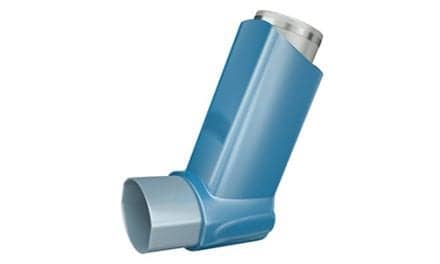 |
| Special brochure just for kids |
This month, more than 300 allergists from the American College of Allergy, Asthma & Immunology (ACAAI) will host free asthma screenings across the country as part of the 11th Annual Nationwide Asthma Screening Program. The program, sponsored by the ACAAI and cosponsored by the Asthma and Allergy Foundation of America and the Allergy & Asthma Network Mothers of Asthmatics, gives patients of all ages the chance to be tested for asthma, discuss their breathing problems with an allergist, and find out if they require further evaluation.
“Over the years, we’ve screened [more than] 100,000 people. About 50% of them year to year have been referred for further evaluation,” says John Winder, MD, FACAAI, chair of the program and practicing allergist in Toledo, Ohio. “I’m really surprised at that, but it’s been consistent.”
During a screening, patients fill out a questionnaire that consists of yes or no questions regarding situations that might cause them breathing difficulties. After completing the questionnaire, patients take a spirometry test and discuss their results with an allergist. Each screening lasts approximately 20 to 30 minutes.
Winder describes the program as the biggest public education effort the ACAAI has sponsored, and says that millions of people hear about the screenings each year. “What grew out of that was also recognizing the allergist as an asthma specialist,” he says. “That really had not been very well delineated.”
A Special Emphasis
To boost awareness within specific patient populations, the program gives particular focus to a different group each year, and this year, the focus is on young children. As part of the effort, parents and caregivers of children under age 5 will receive a special brochure that addresses asthma in young children.
According to the ACAAI, of the 23 million Americans affected by asthma, 9 million are children. The disease often goes undiagnosed in the very young, however, as parents may confuse asthma symptoms with those of common colds or other viruses. “It’s difficult to diagnose asthma in very young children,” Winder says. “A lot of times they won’t be given the term ‘asthma.’ It’ll be called reactive airway disease or asthmatic bronchitis or wheezy bronchitis. Their physicians or caregivers are sometimes loath to use the word asthma.”
Although both children and adults fill out questionnaires during the screening, the child’s version is called the Kids’ Asthma Check. This questionnaire is similar to the 20-question Life Quality Test administered to adults, but the questions are more specific to a child’s day-to-day experiences. For example, whereas adults are asked whether they have difficulty breathing while “do[ing] simple chores,” children are asked whether they have trouble breathing when “playing hard with friends.” The questionnaires also feature a section for those who have been diagnosed with asthma to assess their concerns and determine whether their asthma is under control. Parents of children younger than 8 years old fill out the Kids’ Asthma Check, while older children can fill it out themselves.
The questionnaires for both children and adults also are available to the public on the ACAAI Web site, www.acaai.org.
“[People] can actually download the Life Quality Test or the Kids’ Asthma Check and have it with them, already completed, when they go for the screening,” Winder says.
Although this year’s program places special emphasis on young children, Winder says that the screenings are designed for everyone. “We really target two populations—someone at any age who’s having breathing problems and hasn’t had a diagnosis, and people who have asthma and would like the opportunity for a 20,000-mile checkup,” he says. “Are they receiving state-of-the-art care? Is their asthma too much in their face? Then it shouldn’t be.”
Providing free screenings also allows people access to care that they might not have had otherwise. During one of his first years with the program, Winder held a screening at a suburban mall. As soon as the doors opened, two homeless men from a rescue mission approached the booth. One of the men had seen a notice for the free screening in the paper and wanted his friend, who had difficulty breathing, to be tested. “They scraped up enough money between the two of them to get the one-way fare for the bus to come out to the suburbs,” Winder says. The man had such severe asthma that he was taken to a local hospital.
“I think maybe that contributed to me continuing on to be the chairman each year, because I saw what we were doing,” says Winder, who has served as chair for 10 of the program’s 11 years.
With the current privacy rules under HIPAA, there is no mechanism for the ACAAI to track what happens to patients after they leave the screenings. “They take a copy of their questionnaire and their spirometry [results]. But we really don’t know what happens,” Winder says. “Does the family doctor treat them or send them on for further evaluation? We wish we knew.”
Although the direct results for each patient are unknown, Winder says that the public education effort has been a success. “More and more people are certainly becoming aware of asthma, and what we have done with the asthma screening program has really contributed to that,” he says. “Last year was our 10th year, and there were more than 600 media placements around the country. Probably 250 million people heard about the asthma screening in some fashion, whether it was in print media or national trades or on television.”
A Community Effort
Recognizing that asthma affects every walk of life, volunteers offer screenings in every part of the community—from the inner cities to the suburbs—and even on Capitol Hill, where the event kicks off each year. The program is held in May as part of National Asthma and Allergy Awareness Month. Venues include malls, office buildings, health fairs, and other accessible locations chosen by participating allergists, who coordinate the event with the venue’s personnel. Typical screenings are half-day events and attract between 25 and 100 people.
“We did our screening last year at an inner-city baseball tournament, and it was supported by the police athletic league,” Winder says. “We had several teams and their families from the various schools that were there, and it was very successful.”
To get the word out to the public about the screenings, the ACAAI has developed a comprehensive marketing campaign, which makes publicizing the program easier for participating allergists. Volunteers receive a packet of publicity materials, including form letters, brochures, banners, flyers, and even public service announcements (PSAs). “Nothing has to be created,” Winder says. “And I think that’s one of the reasons it’s been so successful, because everything is done, from timed-out PSAs for radio, to copy to go into magazines, journals, and newspapers.”
Another key element is involving the medical community. Participating allergists can bring in other volunteers, such as pulmonologists, respiratory therapists from local hospitals, and even other allergists who are not members of the ACAAI. These volunteers often help perform screenings and sometimes provide supplies such as mouthpieces and spirometers. Representatives from AstraZeneca, a Wilmington, Del-based pharmaceutical company that provides funding for the program, are also on-site to help with the screenings.
“If there’s a training program for respiratory therapists, we’ll have respiratory therapy students come and do the spirometries,” Winder says. “We get a lot of people around the medical community that will participate. It’s a real community effort.”
To recruit volunteers within the ACAAI, the college sends out reminders with its annual report to keep its membership abreast of information such as themes for the coming year and sign-up deadlines. “We’ve had several hundred of our members do screenings. Some of them come back year after year, and we’re always trying to attract new ones to do it,” Winder says.
In the future, Winder hopes to see the Nationwide Asthma Screening Program continue to grow so that the message reaches as many people as possible. With consistently good turnouts every year, he says that the message appears to be taking root.
“It’s just been phenomenal,” Winder says. “I hope [we] continue to add more of our membership as coordinators, see [the program] grow, and continue to raise the level of awareness of asthma.”
Ann H. Carlson is a contributing writer for RT. For further information contact [email protected].









